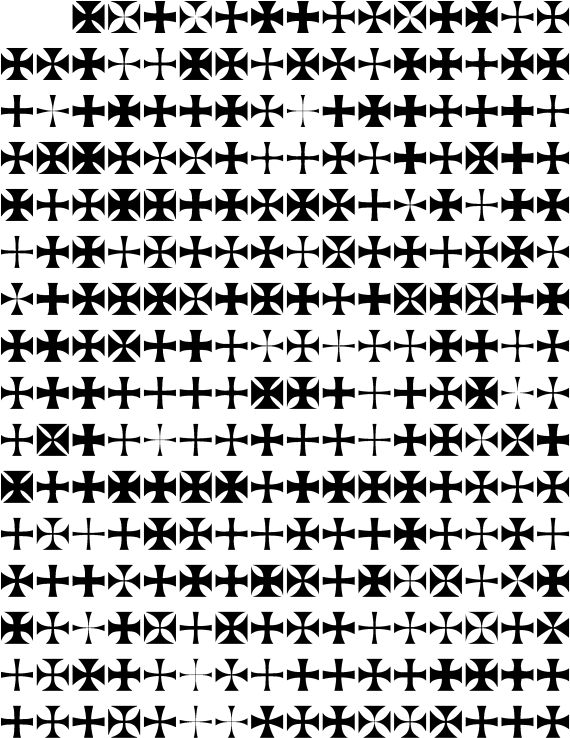
Explanation
December 29, 2002
The Maltese cross and the Juuji font
History
¶
The Maltese cross has become known
as the proud symbol of firemen everywhere.
I cite from this source:
"The insignia of the fire service is the Cross Pattée-Nowy, otherwise known as the Maltese Cross. This cross represents the fire service ideals of saving lives and extinguishing fires. The fire service borrows the cross from the Knights of Saint John of Jerusalem, a charitable, non-military organization that existed during the 11th and 12th centuries. A white or silver cross on a dark background was adopted by these Knights of Hospitallers, as they were also known, because of their charity toward the sick and poor in setting up hospices and hospitals. Later they assisted the Knights of the crusades through their goodwill and also through military assistance in an effort to win back the Holy Land. The Knights of St. John eventually moved to the Island of Malta, the island for which the Maltese Cross was named."
¶
Of course, crosses have been used as religious icons
for centuries. There was a large variety of them during
the crusades from the 12th through the 15th centuries.
The following picture was taken from a survey of such crosses
by the reverend
Michael Foster.
Here we see that the Maltese cross is not what we usually think
it is. In fact, the Cross Pattée is more like what is used
in practice, with perhaps less flaring near the ends.
The Cross Formé is softer, gentler, and
as we will see further on, has become the standard symbol
for "Maltese cross", even though that name is thus historically
incorrect.

The font situation
¶
It is perhaps surprising that Maltese crosses have
a precise mathematical definition, at least according to
Steve Wolfram
at Mathematica. It was taken from the book by
G. Frederickson
entitled "Dissections: Plane and Fancy"
(New York: Cambridge University Press, pp. 157-162, 1997),
chapter 14 (Maltese Crosses).
¶
Unicode
has reserved position U+2720 for the Maltese cross,
in the Cross Formé form suggested by Hermann Zapf in
Zapf Dingbats, character 64.
¶
A similar form has thus been adopted as the
norm in most full or substantive Unicode fonts,
such as
Arial Unicode, Bitstream Cyberbit, Palatino Linotype Italic, or Verdana.
However, it is clear that for serious printing, we need
a better choice of crosses, and the Juuji font and its
derivatives attempt to fill that void.
The Juuji font
¶ The Juuji font is part of the Sugaku series. These fonts are free.
 |
|

|
Copyright © 2002
Luc Devroye
School of Computer Science
McGill University
Montreal, Canada H3A 2K6
luc@cs.mcgill.ca
http://cg.scs.carleton.ca/~luc/index.html